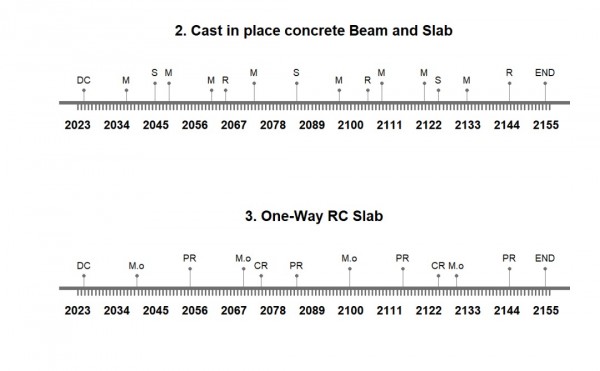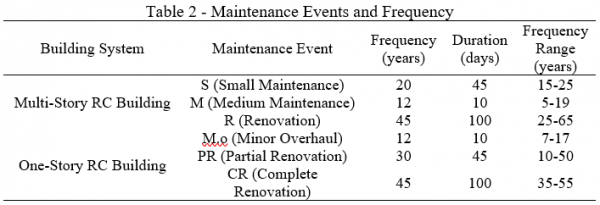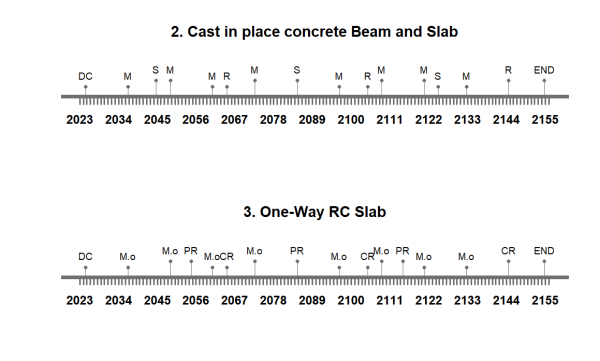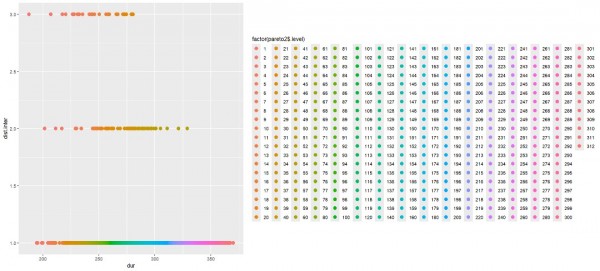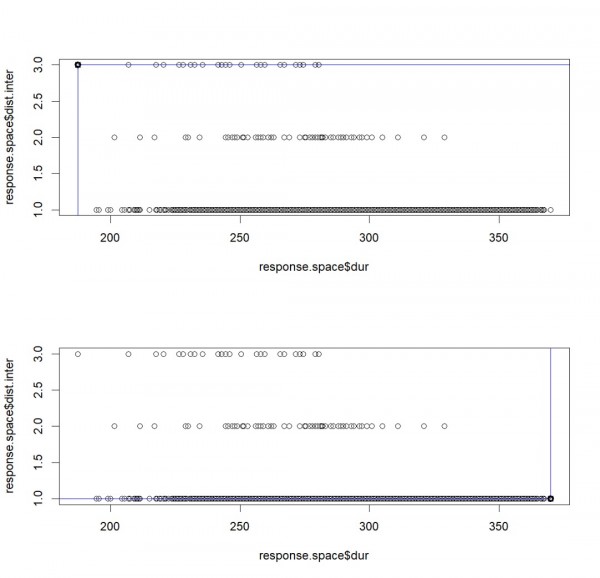Introduction
The primary service level of the integrated system, comprising one-story and multi-story residential buildings, is to provide continuous and reliable housing for residents. To maintain this service level, it is crucial to implement effective maintenance strategies that prevent disruptions in essential functions such as structural integrity, accessibility, and habitability. Without proper maintenance, issues such as structural deterioration, system failures, and environmental impacts could compromise the safety and comfort of the residents. To minimize the duration of maintenance events and reduce downtime, an optimized strategy must be defined that combines similar maintenance activities for both buildings. By synchronizing inspections and repair actions, the frequency of service interruptions can be reduced, ensuring a more efficient and cost-effective approach to long-term maintenance planning. Based on research by Ianchenko et al. (2020), the average estimated lifespan of residential buildings is approximately 130 years[1], which we have adopted for this analysis.
Integrated Maintenance Strategies
Strategy 1- Uncoordinated Maintenance approach
One approach to maintenance planning is to address all maintenance events for both systems individually, without any attempt to combine or bundle similar tasks. This method, referred to as the Baseline Strategy, represents an Uncoordinated Maintenance approach, where each system follows its default, unoptimized maintenance schedule. In our strategy, while maintaining the overall structure of the two timelines, we eliminated redundant maintenance tasks occurring at the same time within a single timeline. As a result, maintenance activities are conducted based solely on their predefined frequency and duration, without considering potential efficiencies from synchronization. Table 1 presents the maintenance events[1-3] for each system under this strategy which is displayed in Figure 1. Due to the lack of coordination, the total duration of all maintenance activities accumulates to 800 days (Figure 2) during 130 lifetime years[4], leading to prolonged disruptions and inefficiencies in service continuity.
Figure 1.
Figure 2.
Strategy 2- Bundled Maintenance approach
The second maintenance strategy involves adjusting the frequency of certain activities to align adjacent maintenance tasks, allowing them to be conducted simultaneously. By synchronizing maintenance events between the one-story and multi-story buildings, this approach reduces downtime, minimizes disruptions, and optimizes resource allocation. Instead of performing maintenance independently for each system, similar or related tasks are bundled together at the same time points, creating a more efficient and coordinated maintenance schedule.
Combination 1:
In this adjusted plan, the renovation frequency of the multi-story building has been increased from 40 to 45 years, aligning it with the complete renovation cycle of the one-story building, which was also adjusted from 50 to 45 years. Similarly, the minor overhaul frequency of the one-story building has been synchronized with the medium maintenance of the multi-story building at 12-year intervals. These adjustments allow for better coordination of maintenance activities, reducing the number of separate interventions required over the buildings’ lifespan. Table 2 presents the maintenance events for each system under this strategy which is displayed in Figure 3.
Figure 3.
By implementing this new strategy, the overall duration of maintenance activities is significantly reduced. Compared to the baseline strategy, which resulted in 800 days of total maintenance duration, the adjusted approach optimizes scheduling and minimizes disruptions. Through bundling and better coordination of interventions, the total duration of maintenance activities is now reduced to 595 days (Figure 4) in a 130-year lifetime.
Figure 4.
Combination 2:
We adjust the frequency of the maintenance method “CR” from 50 to 40 years to explore an alternative combination, as shown in the timeline below (Figure 5.).
Figure 5.
In this combination, the total duration of maintenance activities is now 605 days in a 130-year lifetime (Figure 6.).
Figure 6.
Based on our preference for the shortest duration and longest intervals, we compared the duration of each strategy and ultimately selected Bundled Maintenance Strategy Combination 1 as the optimal choice.
Optimization of Maintenance Scheduling Strategies
Our goal is to show how different maintenance scheduling strategies affect the total duration of maintenance while improving efficiency and reducing disruptions. This analysis is essential for integrated maintenance planning in our combined systems of one-story and multi-story RC residential buildings, helping to identify the most effective strategy to minimize downtime. To illustrate this, Figure 7 presents a scatter plot that visualizes the relationship between maintenance duration (dur) and discrete intervention levels (dist.inter).
Figure 7.
As shown in Figure 2, there are 312 different combinations of maintenance events, representing various optimization scenarios where schedules are adjusted to minimize the duration of each activity while maximizing the intervals between them. Each point on the scatter plot corresponds to a specific evaluated maintenance scenario. These scenarios are categorized into three distinct levels based on the frequency and bundling of maintenance activities:
- Level 1: it shows frequent but short-duration maintenance events, where maintenance is performed individually for each system with minimal bundling
- Level 2: in this case moderate bundling of maintenance tasks is illustrated, where some interventions are synchronized to optimize efficiency.
- Level 3: it represents highly bundled maintenance schedules, where interventions are planned together to minimize the number of interruptions.
To evaluate different scheduling options and determine the most effective strategy, we prioritize maintaining serviceability by reducing maintenance duration and maximizing intervals between interventions. To achieve this, Figure 8 is generated using Pareto frontier analysis, which helps identify optimal maintenance strategies. This analysis suggests that the best approach is to minimize the total duration of maintenance activities while maximizing the time between consecutive interventions, ensuring both efficiency and minimal disruption to residents.
Figure 8.
References
[1] Ianchenko, A., Simonen, K. and Barnes, C., 2020. Residential building lifespan and community turnover. Journal of Architectural Engineering, 26(3), p.04020026. Available at: https://ascelibrary.org/doi/abs/10.1061/(ASCE)AE.1943-5568.0000401
[2] O’Flaherty, C.A. (2018). Highway Engineering Handbook: Building and Rehabilitating Infrastructure. McGraw-Hill Education. https://archive.org/details/highwayengineeri0000ofla
[3] ACI 546R-14 (2014). Concrete Repair Guide. American Concrete Institute. https://www.concrete.org/portals/0/files/pdf/previews/546r_14_preview.pdf
[4] Fib Model Code (2010). Model Code for Service Life Design. Fédération Internationale du Béton. https://www.fib-international.org/publications/fib-bulletins/model-code-2010-first-complete-draft,-vol-1-pdf-detail.html

